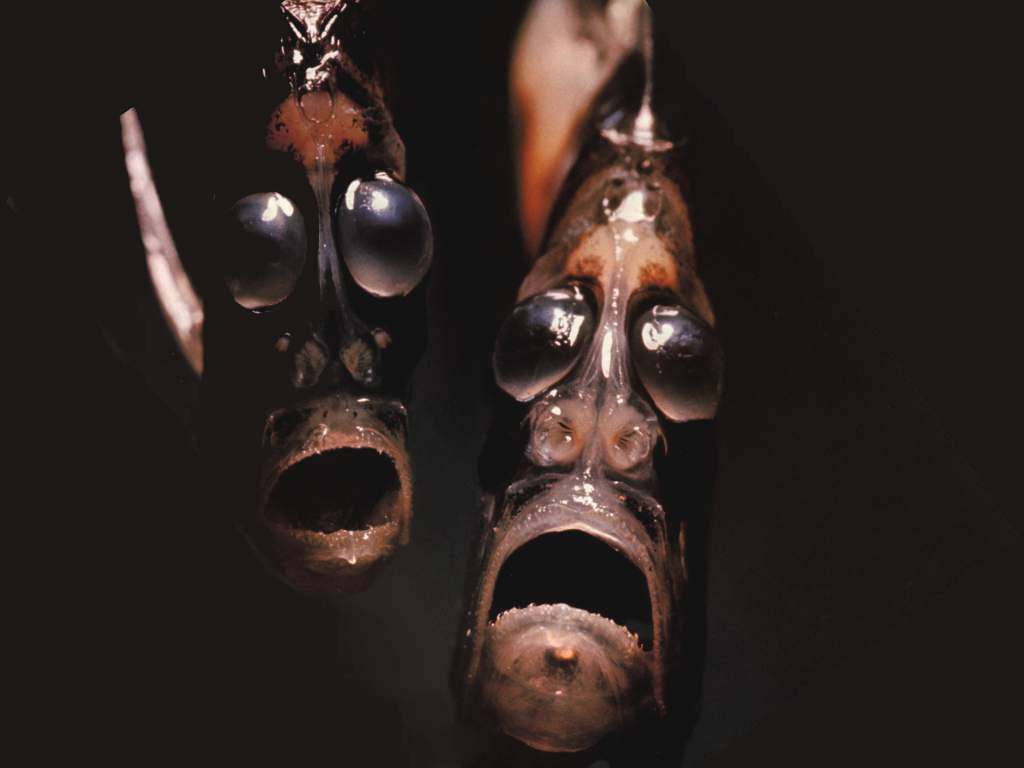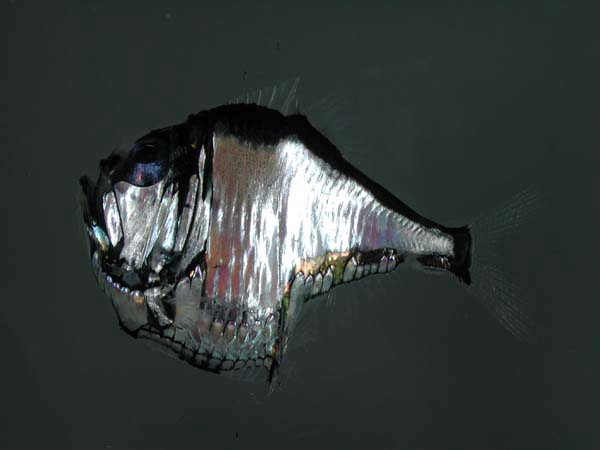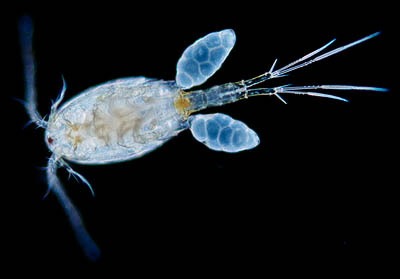"More people have travelled into space than have ventured this deep."
I watched David Attenborough's series Blue Planet, but my favourite episode by far was The Deep. Yes, a long-awaited educational piece! My first since the Pompeii or volcano post, I believe.
It is filmed around the Marianas Trench in the Pacific. After the continental shelf ends, the terrain levels out and gently slopes for 150 miles until it reaches a depth of 3,000 metres at the abyssal plain.
The team can travel up to 3 miles down in Alvin, a 2-metre wide submersible with a thick titanium skin and portholes no larger than your hand - any larger and the vessel would implode under the pressure.
The Twilight Zone, or Mesopelagic Zone (Middle Sea) extends from 450 ft (150m) to 3,300 ft (1,000m).
At around 600 metres, it all changes. The sunlight barely filters down this far, signalling the end of photosynthesis. The only colour of the spectrum down here is blue. Creatures you had not thought physically or naturally possible dwell down here, species never before seen, aliens on our own planet.
The pressure is 20-100 times that on the surface. Eyes as big as marbles, transparent squidgy bodies, bioluminescence - all the norm down here. The sealife lives in a floating world with no surfaces to come into contact with and are therefore much less durable than their shallow water cousins. (Hence it intrigues me as to how a soft squid can live here without being squished, while the bathysphere is protected by very thick walls.
The hatchet fish is so narrow that it is barely visible head-on:

but let it turn for its silvery side to mirror the blue light

...and it becomes invisible, even from below: it possesses a row of cells on its belly that duplicates the exact colour of the sea above its head.
I even saw an opaque fishy toddling about on footlike fins.
Much of the life down here produces phosphorescent blue light (like that on the HP laptop!), thanks to bacteria contained in cells or contained chemical reactions (much like in our light sticks). The hairy angler "angles" with its blue beacon. Others have photophore cells under their skin. Squid outline the contours of their bodies in blue dots. Shrimp exude a web of blue glue to slow down their predators and coat them with phosphorescence to make them visible to their own predators.

The transparent copepod (of which there are many species and it is the most numerous in the oceans) releases delayed blue-light bombs to confuse its pursuer so it can escape into the gloom.
Red light is filtered out by the water, so a few creatures produce their own, and this is invisible to the others - they look black. One fish (thought he said sniper fish but can't find it) lights its way with a red searchlight in its head, spotlighting its prey who are none the wiser. Some transparent jellyfish produce red light in order to camouflage the blue light of their latest meal. Imagine if your stomach lit up every time you ate. What an easy target you would be.

On the sea floor, the water is clear because there is so little organic matter to cloud it up. Most living down here are loners, feeding on the "marine snow", a sort of manna that floats down from decaying matter in the sunlit waters. A large tuna or a whale might hit the bottom intact. This will attract the six-gilled shark, a living fossil that has remained unchanged for 150 million years.
The carcass of the whale may take up to 18 months to be stripped down to the bone. Even then, it is teeming with bacteria which derive nutrients from the bones, and some eel-like creatures (starts with an h) are still around, finding flesh inside the head cavity. It will actually take years to completely run out of nutrients. When the team revisited the whale 18 months after it landed, the skeleton was laid out like a museum specimen, the outline of the body delineated on the silt floor by white bacteria.
Down by the hydrothermal vents, closest to the earth's skin, a new species is described every ten days. There are creatures that can withstand temperatures up to 80C. The hottest vents reach 400C (752F).
Aside: In the 1990s (a decade after the deep sea vents were discovered) 1/2 a mile under the Gulf of Mexico, far from any solar energy, scientists discovered an underwater lake. A lake underwater, you ask? Indeed. The "shoreline" was made up of shells, the "lake" consisted of briny water, much heavier than the seawater around it. The heavier water even lapped against the shore.
Now, I have seen pictures of people eating the postage-stamp-sized hatchet fish, and Japanese fishermen are able to trawl for bioluminescent squid when they come close to the surface once a year.
Question: would you eat a deep sea creature?
I watched David Attenborough's series Blue Planet, but my favourite episode by far was The Deep. Yes, a long-awaited educational piece! My first since the Pompeii or volcano post, I believe.
It is filmed around the Marianas Trench in the Pacific. After the continental shelf ends, the terrain levels out and gently slopes for 150 miles until it reaches a depth of 3,000 metres at the abyssal plain.
The team can travel up to 3 miles down in Alvin, a 2-metre wide submersible with a thick titanium skin and portholes no larger than your hand - any larger and the vessel would implode under the pressure.
The Twilight Zone, or Mesopelagic Zone (Middle Sea) extends from 450 ft (150m) to 3,300 ft (1,000m).
At around 600 metres, it all changes. The sunlight barely filters down this far, signalling the end of photosynthesis. The only colour of the spectrum down here is blue. Creatures you had not thought physically or naturally possible dwell down here, species never before seen, aliens on our own planet.
The pressure is 20-100 times that on the surface. Eyes as big as marbles, transparent squidgy bodies, bioluminescence - all the norm down here. The sealife lives in a floating world with no surfaces to come into contact with and are therefore much less durable than their shallow water cousins. (Hence it intrigues me as to how a soft squid can live here without being squished, while the bathysphere is protected by very thick walls.
The hatchet fish is so narrow that it is barely visible head-on:

but let it turn for its silvery side to mirror the blue light

...and it becomes invisible, even from below: it possesses a row of cells on its belly that duplicates the exact colour of the sea above its head.
I even saw an opaque fishy toddling about on footlike fins.
Much of the life down here produces phosphorescent blue light (like that on the HP laptop!), thanks to bacteria contained in cells or contained chemical reactions (much like in our light sticks). The hairy angler "angles" with its blue beacon. Others have photophore cells under their skin. Squid outline the contours of their bodies in blue dots. Shrimp exude a web of blue glue to slow down their predators and coat them with phosphorescence to make them visible to their own predators.

The transparent copepod (of which there are many species and it is the most numerous in the oceans) releases delayed blue-light bombs to confuse its pursuer so it can escape into the gloom.
Red light is filtered out by the water, so a few creatures produce their own, and this is invisible to the others - they look black. One fish (thought he said sniper fish but can't find it) lights its way with a red searchlight in its head, spotlighting its prey who are none the wiser. Some transparent jellyfish produce red light in order to camouflage the blue light of their latest meal. Imagine if your stomach lit up every time you ate. What an easy target you would be.

On the sea floor, the water is clear because there is so little organic matter to cloud it up. Most living down here are loners, feeding on the "marine snow", a sort of manna that floats down from decaying matter in the sunlit waters. A large tuna or a whale might hit the bottom intact. This will attract the six-gilled shark, a living fossil that has remained unchanged for 150 million years.
The carcass of the whale may take up to 18 months to be stripped down to the bone. Even then, it is teeming with bacteria which derive nutrients from the bones, and some eel-like creatures (starts with an h) are still around, finding flesh inside the head cavity. It will actually take years to completely run out of nutrients. When the team revisited the whale 18 months after it landed, the skeleton was laid out like a museum specimen, the outline of the body delineated on the silt floor by white bacteria.
Down by the hydrothermal vents, closest to the earth's skin, a new species is described every ten days. There are creatures that can withstand temperatures up to 80C. The hottest vents reach 400C (752F).
Aside: In the 1990s (a decade after the deep sea vents were discovered) 1/2 a mile under the Gulf of Mexico, far from any solar energy, scientists discovered an underwater lake. A lake underwater, you ask? Indeed. The "shoreline" was made up of shells, the "lake" consisted of briny water, much heavier than the seawater around it. The heavier water even lapped against the shore.
Now, I have seen pictures of people eating the postage-stamp-sized hatchet fish, and Japanese fishermen are able to trawl for bioluminescent squid when they come close to the surface once a year.
Question: would you eat a deep sea creature?
powered by performancing firefox
13 comments:
some ugly fish
The fact that a living giant squid was filmed for the first time only within the past few years underscores how little we really know about the great deep. Considering they are a staple of the sperm whale's diet, there has to be lots of them, yet they eluded us for so long!
Deep-sea life isn't squished because it is able to equalize the pressure inside itself to match that outside. On the other hand, if a pressurized deep-sea fish is quickly taken into lower pressure, it literally explodes.
Alvin is still in service? I remember writing a report about it for a science class when I was in elementary school!
yeah that fish really looks hellish
JL - indeedy. Don't want to meet it around a dark corner, eh?
***
Minstrel - yes, but how can such a soft thing do that?
OK I see the parallel that if they come to the surface they explode - it is like us entering the vacuum of space. So they would have to come up in tiny pressurised suits!
hehe.
I think Alvin was commissioned in the early 70s, so possibly.
It may be a newer version of Alvin.
I forgot to mention it is made of titanium.
***
Velvetgunther...Name is familiar...where have I seen you before?
Wow, that's fascinating! I'm not sure if I would consume any of these sea creatures. Maybe it's because I'm not used to them as I am with the sea life at the shallower level.
LOL at Jia Li's comment!
The hatch fish looks like something that comes out of a nightmare, or bad horror movies. But most deep-sea creatures are much prettier, thank goodness.
wooh, thats good. I rather look at pretty fish
Quite a nice educational post,Olivia.:)The hatchet fish looks quite yuck,compared to the usual underwater peaceful beautiful fish we usually see.Me,I wouldn't devour a deep sea creature...Simple reason?I'm a veggie.:)
this was nice reading. u should do this more often!
Gosh, that deep sea lake sounds fascinating.
ML - yes, the things we eat are not ugly, or if they are, they come processed.
***
Mers - good to see you here.
I wish I had included more pictures of the prettier, ethereal things.
***
Amit - what, only veg? No eggs?
***
Prerona - glad you enjoyed. I miss writing like this.
***
Katja - ah, someone who noticed. I would like to learn more about this phenomenon.
Actually, I think the fishies are beautiful. I wish I had a pond full of hatchet fish :-D
I'd love to see that bit about the deep sea lake...I can't imagine it. How can that be?
EAT? Hell no. Most deep sea animals are filled with amonia to keep them afloat. They'd be one nasy meal!
Post a Comment